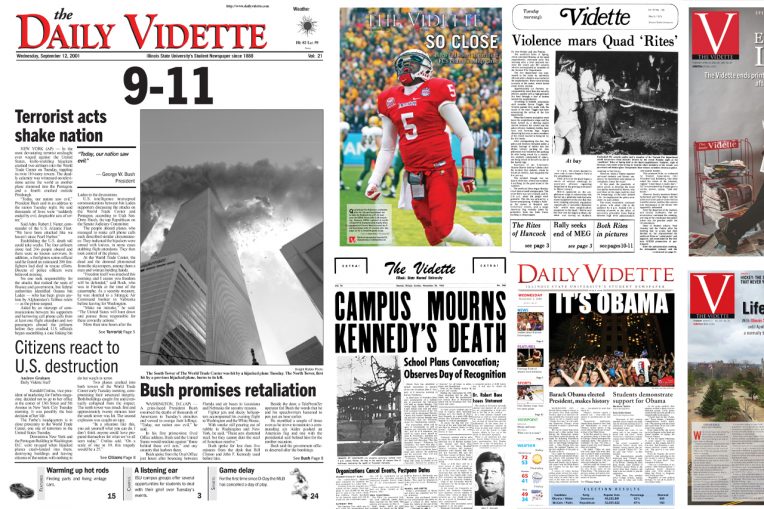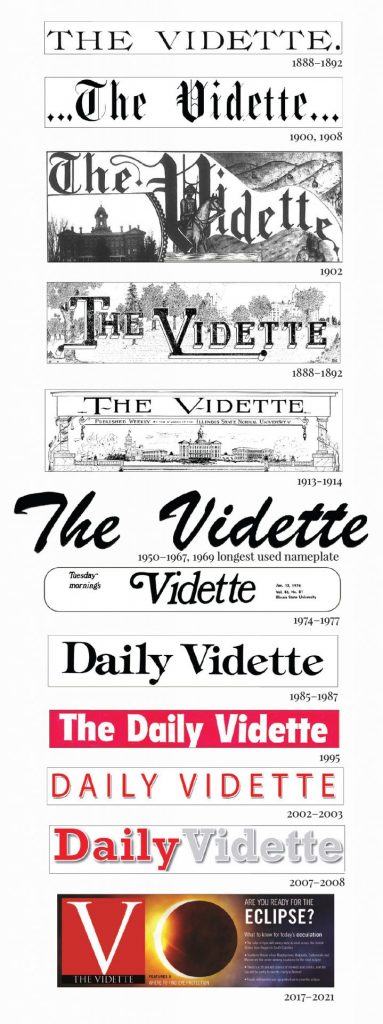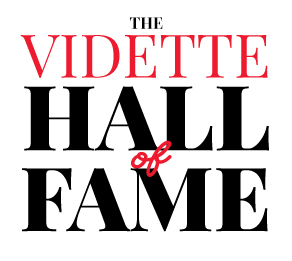Everything seemed to be trending in a certain direction leading up to November 8, 2016—election night in the United States.
With Democratic nominee Hillary Clinton leading the polls over Republican businessman Donald Trump, Ema Sasic ’18 and her fellow student editors and reporters at The Vidette had a roadmap for coverage. They had interviews lined up with people across campus and the community to discuss a Clinton victory.
As election night wore on, it became clear Trump would upset the former Secretary of State. Huddled in their office building at the intersection of Locust and University streets, The Vidette staff shifted to finding other voices to portray the results from a local angle.
Appears InThat moment taught Sasic, now a reporter at The Desert Sun in Palm Springs, California, to always plan for multiple outcomes.
It’s a strategy that has often paid dividends. In late April, Riverside County was set to release its latest COVID-19 numbers. Sasic knew the statistics would signify whether restrictions would be lifted in the area, and that residents would react strongly either way.
“I made sure to write two ledes for that one,” said Sasic, who was at The Vidette from 2015-2018. She served as news reporter and news editor, columnist, and editor-in-chief. She credits Illinois State’s award-winning student newspaper for preparing her professionally. “I feel like everything I’ve been able to accomplish so far is because of the foundation I got from The Vidette.”
For 133 years, the publication has been a student learning lab and keeper of campus history. It has sprung careers ranging from local reporters in communities of all size to business executives, the chief Washington correspondent of The New York Times, and a pair of Pulitzer-Prize winners.
On April 27, staff printed the final paper product. A commemorative edition printed in May is available for purchase on the publication’s website. Starting this fall semester, The Vidette will be entirely online, with all content exclusively on videtteonline.com. It follows the trend of a journalism industry that has become primarily digital as advertising revenue plummets, with consumers increasingly finding their news by searching online sites versus turning the printed page.
Despite shedding its print product, The Vidette will continue its pursuit of excellence and fulfill its mission of preparing journalists to work in an increasingly polarized and fast-paced world.
“That flagship printed piece will be a thing of the past, but the opportunities for students to get the experience, tell the stories, and to lock that information in for historical reference for the University community will still very much be in place,” said The Vidette General Manager John Plevka.
“That flagship printed piece will be a thing of the past, but the opportunities for students to get the experience, tell the stories, and to lock that information in for historical reference for the University community will still very much be in place.”
John Plevka
The paper has had a digital presence for more than a decade. The Vidette produces podcasts and social media specific content, in addition to having video components to stories. The Vidette has been a part of the School of Communication since 2010 in a move for the self-sufficient paper to become less dependent on advertising revenue. With the new organizational model, the School of Communication looks to engrain Vidette-specific courses in its curriculum and could eventually offer “gateway classes” for employment. WGLT will assume business and administrative oversight, as the transition eliminates the publication’s advertising department. The Vidette will keep its independent status, under the guidelines of the Illinois College Campus Press Act.
While there’s a certain rush that comes with placing stories and designing pages into the early morning hours, staff members look forward to expanding the publication’s digital presence. Elizabeth Seils ’21, editor-in-chief during the 2020-2021 school year, said the industry has changed even since she first arrived at the paper in 2018.
For example, Seils remembered using social media primarily for story promotion when she started. Now the paper turns to certain apps for storytelling. That practice will expand with plans to present more content on platforms such as Instagram live and Tik-Tok videos. “It’s kind of evolved from a thing we use just to promote our stories to an active part of how we operate,” Seils said.
Having that versatility will only pay off in the long run, said former sports editor Zack Carpenter ’16, who now covers The Ohio State University football for Eleven Warriors. It is an entirely online publication focused on recruiting and analysis for a Buckeyes’ program that has a huge national brand. Carpenter does it all—from photography and writing to live chats with fans. He is confident that journalists entering the field will all need a similar, well-rounded skill set.
“You have to look at it as a blessing in disguise that you are going to get all your experiences in a digital world, and you’re going into a professional world where it is all digital,” Carpenter said.
The former beat reporter for the Redbird football team engaged in these types of practices as an undergraduate as he experimented with different ways to tell a story. Now covering a team with such a rabid fan base, he appreciates even more the confidence he gained at The Vidette.
Carpenter recalled being shaky and nervous for his first baseball press conference, which he said only had about 10 people present following a game at Duffy Bass Field. Standing up and speaking as part of a credible organization gave him a purpose, and he became unafraid to take risks or challenge himself as he grew at the paper.
“With The Vidette, John (Plevka) gives you freedom to do your thing,” Carpenter said. “He always told us to not be afraid to fail.”
Whether under Plevka’s leadership or Rick Jones, M.S. ’92, before him or that of Harry Thiel decades earlier, the paper has long been a launching pad for motivated students to prepare for a profession they deem worthwhile.
Tina Haisman ’95, a member of the 2011 Vidette Hall of Fame class, started her own business as a life coach and personal relations consultant. She credits the newspaper for allowing her to tap into her creative side. Haisman was on staff all four years as an undergraduate, working as business manager two years.

“The skills I learned at The Vidette set me up perfectly to a life coaching career and running my own business,” she said. “I gained the business skills and also the writing skills for the marketing aspect. It is a school publication, but it gave us all real-world experience.”
While they appreciate the boost in career preparation, student workers past and present are proud of how The Vidette has preserved the University’s story. Plevka said the histories of both the publication and the institution are intertwined.
The Vidette’s digital archives at Milner Library, found at VidetteArchive.IllinoisState.edu, are proof of that. They are used for a wide variety of research, from family genealogies to classroom teachings. A public health course during the spring semester, for example, tapped into past issues to see how campus responded to the Spanish Flu influenza pandemic in 1918.
“It’s just fascinating as hell,” Plevka said. “You can see how we covered things through the years.”
The publication has recorded history as it has unfolded since 1888, but it’s also had its own moments of cultural significance. The paper’s first student editor-in-chief was female, as 1889 graduate M. Kate Bigham led the publication more than 30 years before women had the right to vote.
Ray Richardson ’77 was the paper’s first Black sports columnist, providing perspective from Black students and athletes in a time when race tensions across the country remained high. Undeterred by letters to the editor trying to silence him, Richardson took pride in his work and hoped to inspire other students at The Vidette.
“When you look back on things, you realize that you were the first, but I also wanted to make sure I performed well enough so that I wouldn’t be the last,” Richardson said. He went on to cover the NBA, most notably for the Pioneer Press in St. Paul, Minnesota. “I would hope that what I did paved the way for others to come behind me.”
The Vidette’s history is interwoven with accolades. Staff frequently win a high-volume of awards at the annual Illinois College Press Association contest. Competition is with schools across the state, including the University of Illinois at Urbana-Champaign and Northwestern University. The Vidette won first for General Excellence twice in the last three years.
“Even on a small scale, in this ISU community, it’s nice to know I can make a difference. It makes me want to keep doing that for larger communities and groups.”
Elizabeth Seils
Even though print products are scaling back across the industry, student journalists at The Vidette aren’t deterred from doing important work. They continue to tackle delicate topics such as election coverage, social movements, and the pandemic. They are seeing the impact strong storytelling can have no matter the medium for presentation.
“Even on a small scale, in this ISU community, it’s nice to know I can make a difference. It makes me want to keep doing that for larger communities and groups,” Seils said.
As the paper enters a new era, it does so with an army of former employees and supporters behind it. “The Vidette family,” as alums and current staffers alike call themselves, runs deep, evidenced by an active alumni Facebook page with more than 400 members. They all look forward to seeing the tradition of excellence continue.
“You feel all of that work on your shoulders, and you just want to make sure you are putting out a good product at the end of the day. I always felt that with every single issue and every single story with the hours put in by everybody,” Sasic said. “You felt so proud of that. Even as it moves to a digital presence, I feel there is still going to be so much to be proud of.”
Established in 2007, the campus newspaper’s Hall of Fame recognizes alumni from all sectors of the communication industry.
2007
Carl Hulse ’76 Chief Washington Correspondent The New York Times
Jeff Kraft ’81 Managing Director MarketingWorks, Inc.
Kristen McQueary ’95 Editorial Board Member The Chicago Tribune
Janelle Pettit ’02 District Business Manager Heron Therapeutics
2009
Mike Shelly ’62 Professor Emeritus, School of Communication Illinois State University
Heidi Vorhees ’80 President and Co-owner GovHR USA
Bill Gaspard ’82 Design Director China Daily (Beijing)
Jay Blunk ’86 Executive Vice President of Business Operations Chicago Blackhawks
Todd Heisler ’94 Photographer The New York Times 2006 Pulitzer Prize winner
Harry Thiel General Manager The Vidette (1976-1996)
2011
Marc Lebovitz ’72 Media Relations Staff, Retired, Illinois State University
Ben Cordani ’96 Assistant Director of Global Trade Compliance Caterpillar Inc.
Tina Haisman ’95 Certified Life Coach Business Growth Strategist
Bill Mulvihill ’98 Head of Sales, Media, and Entertainment Conde Nast (New York)
2014
Ed Pyne ’71 Publisher, Normalite and Lexingtonian
Rick Jones, M.S. ’92,General Manager The Vidette (1996-2012)
John Abrams ’90 Chief Executive Officer Venzee
Alex Reside ’10 Photography Producer Apple
2016
Chris Ruys ’71 Founder Chris Ruys Communications
Jim Munz, M.S. ’92 Business Manager The Vidette (1980-2001)
Jeff Knox ’98 Senior Director of Visuals The Daily Herald (Chicago)
Scott Gleeson ’11 National Sports Reporter USA Today
Shannon Murphy ’05 Vice President and Client Growth Lead Bluedog Design
2018
Bryan Bloodworth ’79Former Sports Editor The Pantagraph
Sally McKee ’83 Former Managing Editor Peoria Journal-Star
Tony Andracki ’87 Digital Content Manager and Cubs Reporter Marquee Sports
Jim Kirk ’90 Publisher and Executive Editor Crain Chicago Business
Mitch Pugh Executive Editor Post and Courier (Charleston, South Carolina) 2015 Pulitzer Prize winner
2020
Mick Hubert ’76 Sportscaster University of Florida
Kevin Petschow ’81 Senior Director of Public and Analyst Relations Syniverse
Jason Piscia ’96 Director of Public Affairs Reporting Master’s Program University of Illinois-Springfield
Anna Trefil-Frazier ’06 Director of Advertising Journal of American Medical Association



